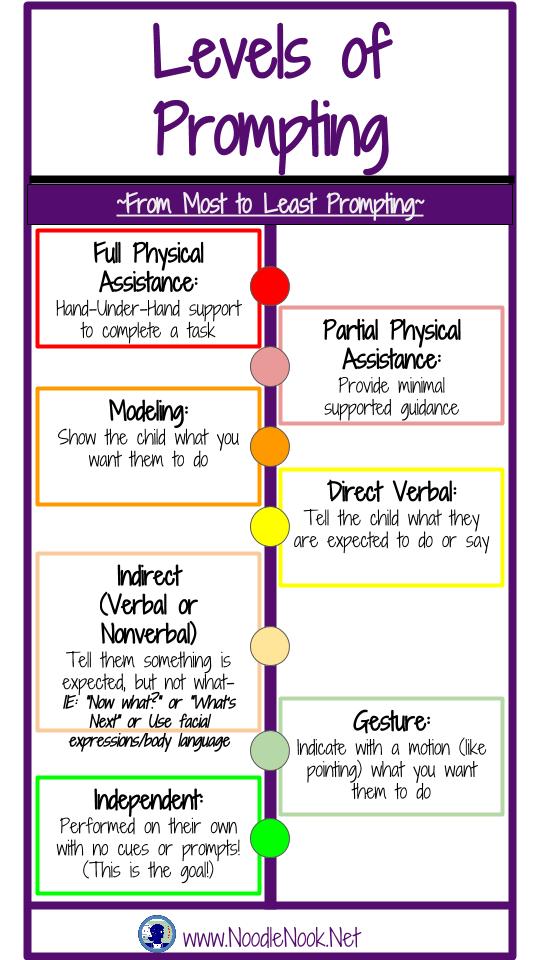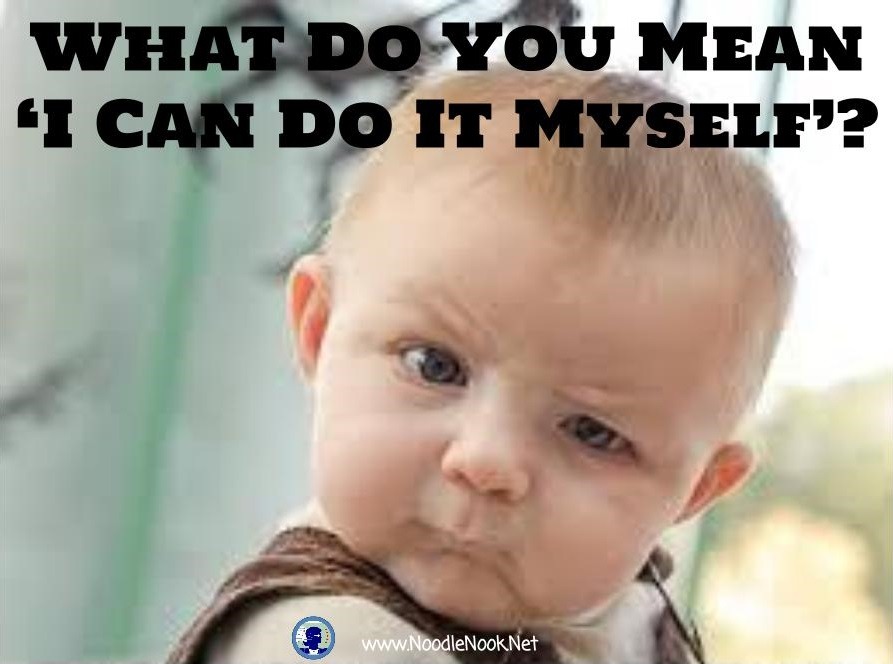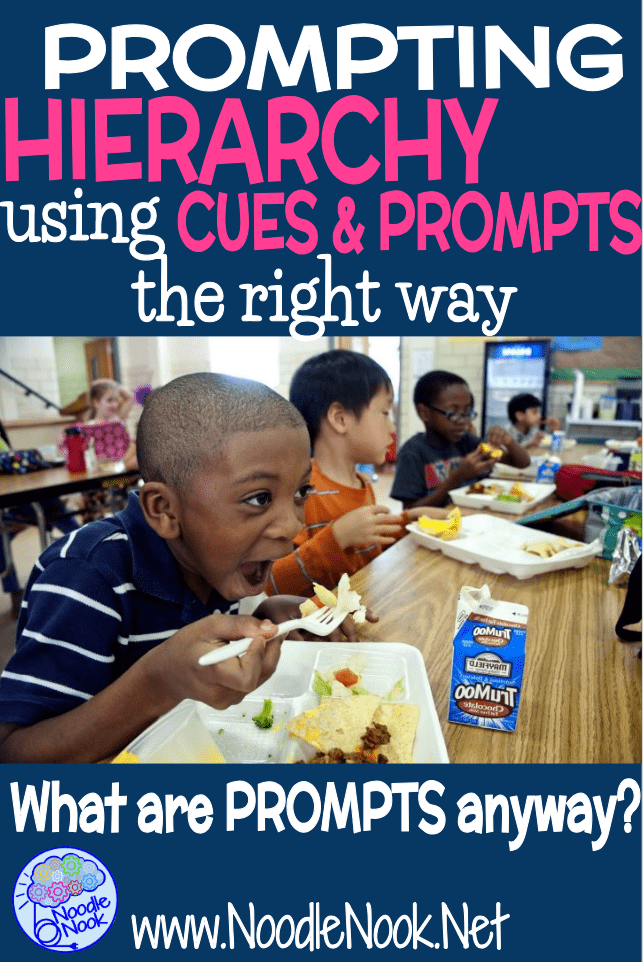I was duped. And I know you will understand that it wasn’t the student duping me- I duped myself because I didn’t use the prompting hierarchy!
I will never forget the day I took a group of students to Taco Bell for a Community-Based Instruction Trip. There was a student in a wheelchair who required a high level of support on campus. We cut her food, opened all her packaging, and even put food on the fork at times to make sure she has access. With the limited use of one side of her body and processing delays, she just needed it.
How I Got Duped!
On the trip, my two paras and I were juggling a lot of balls. We helped this student order, pay for, and get her food to the table, but then wanted to help a few others before we sat down with her to help open, cut, and feed her.
After all the students were through the line, I went to her while my paras helped other students. When I got to her table, she was already eating her taco. Then I asked the table who had helped her. The other students shrugged. I asked my paras who had helped her and they both shrugged. I looked at her and asked her who had helped her. She said “No one- I was hungry”.
From Hand-Over-Hand to Independent
Well, my mouth fell open. She had opened the taco, and taken a few bites… she had even opened and put hot sauce on the darn thing.
And all this time we were doing it all, everything for her.
She had learned if she did nothing, we would do everything. Duped.
That day changed things forever, but I asked myself how I could have missed it. I talked to my paras about what had happened and we were all flummoxed. But we all came back to the same thing: It’s what we had always done for her.
That was when we had to sit down and have a serious conversation with our team about what prompting looks like. We walked through this printable about the hierarchy of prompting and discussed what that looked like at each stage.
Download this Prompting Hierarchy Infographic on Teachers Pay Teachers (that way it is always in your “purchases”) or click here to direct download.
Using the Prompting Hierarchy
Using cues and prompts that are appropriate to support students at their level of need helps you do two things. One, it helps to reduce a student’s level of learned helplessness. Two, it helps to build independence. This is the ultimate goal. Independence. Our use of prompts in the special education classroom is there to build life skills. This is so important in an Autism Unit, Life Skills classroom, or self-contained setting.
Remember This!
The level of prompting will work as you teach any student. It is especially important for students on the autism spectrum, those with complex communication needs, and other special needs students who struggle with new skills.
Often, it is best that an entire team of teachers and support staff review this together. I am always shocked at how often staff views the same assistance as different on the chart! Some think a cue is a prompt… others that a prompt is a cue. To keep everyone on the same page, I suggest you do two things. First, share this prompting hierarchy with your support staff at your next training or professional development. This will help all staff work towards building independence consistently. Secondly, visit the original post and print this poster to hang in your classroom or put in your paraprofessional binder or handbook.
Types of Prompts in the Prompting Hierarchy
There are many different types of prompts. The key to getting to the end goal is to provide the right level of support when a student is faced with a specific question or task. Your prompt level will depend on your ability to answer that question or complete that task.
Full Physical Prompting
The most invasive type of prompt are physical prompts. This is when we actually have to get hands on with students and provide them with extensive supports with hand-under-hand or hand-over-hand support. We may physically guide a child’s hand to help them complete a task. This is the most amount of support we can give.
Partial Physical Prompting
Partial physical assistance is the next most invasive prompt level. It’s not a much different way than full physical, but our invasiveness is less. It still requires some hands-on support.
Modeling
When we provide a student with a model prompt, we’re giving students a model of the target behavior. In other words, you’re showing a student exactly what you want them to do.
Direct Prompt – Verbal or Visual
With a direct prompt, it’s less invasive, but still a clear indication as to what you want a student to do. Here, we’re telling them with a verbal cue or visual cue what to do. This is not a mere hint. These visual and verbal prompts are direct instructions as to what a student should do.
Indirect Prompt – Verbal or Visual
Indirect is different. Here we aren’t telling a student exactly what to do. We’re telling them they should be doing something, but not what. That may be with facial expressions, body language, or visual support. When we use an indirect verbal prompt or indirect visual, I believe it’s better to call it a cue since cues are less invasive than prompts.
Gesture Prompt
Gestures are funny because a gestural prompt can be direct or indirect. It depends on the type of gesture. And if that gesture leads to the answer or is generalized.
Independent
Finally, there is independence. This is the goal, where a student performs a behavior based on a natural cue.
The prompt hierarchy involves providing students with the right level of support to help them answer questions or complete tasks. There are various types of prompts, including full physical prompting, partial physical prompting, modeling, direct prompts (verbal or visual), indirect prompts (verbal or visual), gesture prompts, and independence. Physical prompts involve hands-on support while modeling involves showing students what to do. Direct prompts are clear instructions while indirect prompts provide cues without specific instructions. Gesture prompts can be either direct or indirect, and the ultimate goal is to achieve independence where a student can perform a behavior based on a natural cue.
Invasiveness of the Prompt
As you provide different levels of support to help students complete tasks with more independence, remember this. The goal is independence. As you work with students, don’t use inappropriate prompting. Work through the prompting hierarchy from least-to-most prompting, not most-to-least prompting. In other words, provide the least amount of support first. When a student is unable to do the task independently, escalate to a more supportive prompt on the hierarchy.
Fading the Prompts
As you work to fade a prompt while working with an individual student, stop and reflect. Are you providing the least intrusive prompt? Or, like a special education teacher or paraprofessional who has a million things to do in the classroom, do you do it for a student? If you are doing it for them, then you’re contributing to prompt dependence.
Big Take-Aways from the Hierarchy of Prompting
For us, it was a great reminder about how we needed to re-frame what we do. Our goal is to get to independence. We need to be thinking about a student doing it themselves all the time, every day. I know our students need support in so many things, but then the next question should be what can I put in place to move away from my hand-over-hand assistance to get to the next level? Is it a visual? Or is it a cuing system? Is it a repeated sequence? Or is it as simple as making a student try some tasks independently just to see what happens and reassess our support? Either way, we had to stop being so helpful so we could be more helpful!
Don’t Forget Wait Time!
Our team also needed to have a conversation about wait time. And this happens to all of us. We condition our students to simply learn to out-wait us.
We have a million things to do. When we tell a student to open their taco, they are just working on that one task while we are multi-tasking like crazy! What we often get into is not waiting for them to at least try.
So maybe I give a directive and move on to something else. The student will either learn we can’t be out-waited, or learn self-advocacy by asking for assistance. Either way that’s a win in my book!
What we cannot do is pacify our students by teaching them through our behavior that we will do it for them if they just wait long enough. We have to wait for them to try and let that be our base expectation.
Read More About Wait Time HERE!
Remember All the Steps In Between!
Our other big takeaway was reviewing all the steps between full hand-over-hand support and independence. You don’t give a directive, wait a couple of seconds, and then just do it for them… you move through the prompting hierarchy (so you may want to print a few of these and have them around your classroom). Think of what that really looks like with students. Practice what that will look like with students. And be sure you, as the teacher, model what you preach and more through all the levels as you work with students.
Never Duped by a Taco Again!
Turns out my Taco Student had an entire set of skills she had kept hidden. It was her second year with us and, taking the notes from her previous school to heart as to the level of support she needed, we jumped into action with loads of help.
But what others do is not the gold standard of what is done.
With every new student, be sure to form your own opinion as to what they really need to be successful, continually challenge students to attempt new things, and always, always, always be thinking of ways to fade the support you give.
The goal is independence. Independence.
Get A Handy Guide and Comment Below!
Are you dying for more information? There is an in-depth printable from the geniuses at UNC that walks you through all the levels of prompting with examples, a sample data sheet, and more lingo for your academics available here. It includes different kinds of signals for students when you are cueing, types of positive reinforcement and how to use it, and ideas discussed like natural consequences. Worth a quick read. Need a few pages and more visuals? Try this quickie over at UNR here.
Finally, what experiences do you have with students and the hierarchy of prompting? Do you have your own TACO story? Please share (I will feel better knowing I am not the only one out there that was duped). Have a success story moving a student through the hierarchy? Share that too. It helps us all to hear about successes. And keep up the great work!
Download this Prompting Hierarchy Infographic on Teachers Pay Teachers (that way it is always in your “purchases”) or click here to direct download.






Great resource! We will be linking to this excellent post on our site. Keep up the great writing.
i brought this to my teaching partner and we talked about it wilh our para team. i can already see the difference in how they deal with our students. great share
I have been loking for something like this and i am glad i found this. I plan on printing this for my classroom and talking about it with my team. It is vey helpful to think about this when we work with the kids.
Thanks!
LOVE this! I will be sharing with all the teachers I coach! Do you have the chart you made available for download?
I am so glad you liked this and that it may help the teachers you coach! I uploaded the printable into my store so you can easily download a copy.
Good Luck!
https://www.teacherspayteachers.com/Product/Levels-of-Prompting-Infographic-Cues-and-Prompts-in-Autism-Units-LIFE-Skills-2939013
Pingback: Including Our Level 3 Kids – Specials Ed
Hello!
Where would you put a “visual prompt” on this hierarchy and is there a way you can add it or send me the file to edit?
Is the visual prompt to tell them what to do (like a direct verbal) or to tell them that something what must be done (like an indirect verbal)?
You would align them with those two levels…
Good Luck!
Comments are closed.